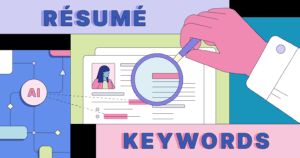In today’s competitive job market, getting your resume noticed can feel like an uphill battle. One of the key obstacles is the Applicant Tracking System (ATS) that many companies use to screen resumes. Just like SEO (Search Engine Optimization) helps websites rank higher in search results, using the right keywords in your resume can help you pass through ATS filters and land an interview. Here’s an easy-to-scan guide to understanding and using keywords effectively in your resume.

Understanding ATS and Its Importance
ATS is software used by employers to filter applications based on specific criteria before a human ever sees them. It scans resumes for keywords related to the job description and ranks them accordingly. Resumes that don’t meet the keyword criteria are often discarded, regardless of the applicant’s qualifications.
Why Keywords Matter:
- Relevance: ATS checks for relevant skills, experiences, and qualifications that match the job description.
- Ranking: Just like search engines rank websites, ATS ranks resumes. The higher your resume ranks, the more likely it is to be seen by a human recruiter.
- Efficiency: Using the right keywords saves time for both you and the employer, ensuring your resume highlights the most important aspects of your experience.
Finding the Right Keywords
Job Descriptions:
- Primary Source: The job description is your primary source for keywords. Analyze it thoroughly to understand the skills, qualifications, and experiences that are most important for the role.
- Highlight Key Terms: Look for repeated terms and phrases. These are likely the keywords the ATS will prioritize.
Industry Standards:
- Research: Use resources like industry-specific job boards and professional organizations to identify common keywords in your field.
- Professional Profiles: Look at LinkedIn profiles of successful professionals in your industry to see which terms they use.
Tools and Resources:
- Online Tools: Use tools like Jobscan and Resume Worded to compare your resume against job descriptions and identify important keywords.
- Company Websites: Visit the careers section of company websites to find additional keywords that might not be in the job description.
Incorporating Keywords Effectively
Natural Integration:
- Avoid Keyword Stuffing: Just like with SEO, stuffing your resume with keywords can make it look artificial and decrease readability. Aim for a natural flow.
- Context Matters: Use keywords in the context of your actual experience. For example, if the job requires “project management skills,” mention specific projects you’ve managed.
Sections to Optimize:
- Summary/Objective:
- Example: “Results-driven Marketing Specialist with expertise in SEO, content marketing, and social media strategy.”
- Skills:
- Example: List both hard and soft skills. Hard skills might include “data analysis,” “Python programming,” or “budget management,” while soft skills might be “team leadership” or “problem-solving.”
- Experience:
- Example: Describe your responsibilities and achievements using keywords. Instead of “Managed a team,” say “Led a team of 10 in developing and executing marketing campaigns.”
- Education and Certifications:
- Example: Include any relevant certifications that match keywords from the job description, like “Certified Scrum Master” or “Google Analytics Certified.”
Using Keywords Like an SEO Pro
Long-Tail Keywords:
- Definition: Long-tail keywords are more specific phrases that are less common but highly relevant.
- Example: Instead of “marketing,” use “digital marketing strategy” or “content marketing campaigns.”
Synonyms and Variations:
- Broaden Your Scope: Use synonyms and variations of important keywords to increase your chances of matching the ATS criteria.
- Example: If the job description mentions “customer service,” also include “client relations” and “customer support.”
Bullet Points and Formatting:
- Readability: Use bullet points to make your resume easy to scan. This helps both the ATS and human recruiters quickly identify key information.
- Consistency: Ensure your formatting is consistent. This includes using the same tense, punctuation, and font style throughout your resume.
Real-Life Examples and Case Studies
Example 1: Digital Marketing Manager
- Job Description Keywords: SEO, PPC, Google Analytics, content marketing, social media.
- Resume Application:
- Summary: “Experienced Digital Marketing Manager skilled in SEO, PPC, and content marketing.”
- Skills: “Google Analytics, social media strategy, content creation.”
- Experience: “Developed and executed SEO and PPC campaigns that increased web traffic by 50%.”
Example 2: Software Engineer
- Job Description Keywords: Java, Python, Agile, software development, problem-solving.
- Resume Application:
- Summary: “Proficient Software Engineer with expertise in Java, Python, and Agile methodologies.”
- Skills: “Software development, problem-solving, Agile project management.”
- Experience: “Led a team in developing software applications using Java and Python, resulting in a 30% increase in efficiency.”
Final Tips for Success
Regular Updates:
- Continuous Improvement: Regularly update your resume to include new keywords and skills relevant to the latest job descriptions.
Tailor for Each Job:
- Customization: Customize your resume for each job application. Tailoring your resume to match the specific keywords and requirements of each job increases your chances of passing the ATS.
Proofread:
- Attention to Detail: Spelling and grammar mistakes can affect ATS results. Proofread your resume to ensure it’s error-free and professionally presented.

What we Learned so far….
Optimizing your resume with the right keywords is crucial in today’s job market. Think of it as applying SEO strategies to your job search. By understanding how ATS works and effectively incorporating relevant keywords, you can significantly improve your chances of landing an interview and, ultimately, your dream job. Remember, just like SEO, it’s about balance, relevance, and providing value. Good luck!


